Notice: This is only a preliminary collection of relevant material
The data and research currently presented here is a preliminary collection or relevant material. We will further develop our work on this topic in the future (to cover it in the same detail as for example our entry on World Population Growth).
If you have expertise in this area and would like to contribute, apply here to join us as a researcher.
In this entry we study the history of books over the last centuries.
Several recent research papers and books have made it possible to follow the rise of book production. The crucial event was the invention of the printing press by Gutenberg around 1440. But we will also study the history of manuscripts that preceded printed books. Particularly interesting is the transition from manuscripts to books – book production became more efficient, prices decreased and the consumption of books increased.
A major driver for the increased production of books is the revolution of literacy, which we study in detail in our literacy entry.
All our charts on Books
Production of manuscripts and books from 500 to 1800
The increased production of manuscripts and books was estimated by Buringh and Van Zanden (2009).1
The unit of analysis for the estimates of manuscripts is the number of individual manuscripts. The unit of analysis for the estimates of printed books is (new) ‘title’ or ‘edition’. The authors corrected the numbers to account for the underrepresentation of estimates for different geographical regions and different times. The authors consider their estimates to be conservative and note that the “figures should be interpreted as low estimates”.
Titles are either books (which have by definition more than 49 pages) or pamphlets (less than 50 pages). The authors define a title as ‘a printed publication which forms a separate whole, whether issued in one or several volumes. Different language versions of the same title published in a particular country should be considered as individual titles’; this includes first editions and reeditions. The authors give the following example: ‘The first printing of Gutenberg’s Bible is one title, and new editions of the Bible will again be counted, but a reprint of exactly the same manuscript would not be included.’
Buringh and Van Zanden note that the aggregation of the data to country levels obscures inequalities within countries – ‘if we could isolate data on, for example, northern Italy or the north of France (including Paris), these regions rank much higher in output per capita’.
The growth of the book sector in Western Europe over the 1300 years studied by the authors is enormous. The most decisive development for the increased book production was the invention of the printing press. Buringh and Van Zanden note: “in the year 1550 alone, for example, some 3 million books were produced in Western Europe, more than the total number of manuscripts produced during the fourteenth century as a whole”.
The rise of the actual number of books is even greater as Dittmar (2012) shows; the number of books printed per edition rose 1450-1600 as depicted in this figure.
Number of books printed per edition, 1450-1600 – Dittmar (2012)2
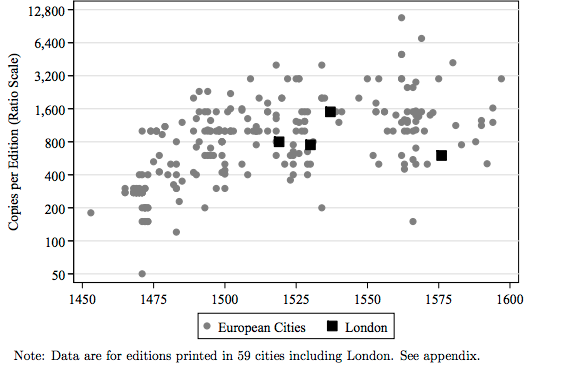
This visualization presents a long-run perspective up until the 21st century.
To make comparisons between countries more meaningful it expresses the number of books in relation to the size of the country’s population. Shown is the number of new book-titles per million inhabitants.
Prices of books: productivity in book production
The increased demand of books was driven by a huge decrease in the price of books. The smaller price was possible by the increased efficiency in the production of books since the invention of the printing press around 1440.
Clark (2008) measures the subsequent productivity increase as the ratio between the wage of building craftsmen and the price of a book and finds a 20-fold increase in productivity in the first 200 years after the invention, as shown in this graph.
Productivity is measured as the ratio between the wage of building craftsmen and the price of a book of standard characteristics. Clark notes that “with both hand production and the printing press the main cost in book production was labor (paper and parchment production costs were mainly labor costs).”
Clark (2008) notes that copyists before the time of the printing press were able to copy 3,000 words of plain text per day. This implies that the production of one copy of the Bible meant 136 days of work. Eisenstein3 is able to compare the price of paying a scribe to duplicating a translation of Plato’s Dialogues with the price for duplicating the same work by the Ripoli printing press in Florence in 1483. For three florins the Ripoli Press produced 1,025 copies whereas the scribe would produce one copy for one florin. This implies that the cost per book decreased 341 times with the introduction of the printing press.
Productivity in book production in England, 1470s–1860s – Clark (2008)4

A long run perspective of the real price of books in the Netherlands between 1460 and 1800 is depicted in this figure.
Estimates of the real price of Dutch books, 1460-1800 (1460/74 = 100) – van Zanden (2009)5
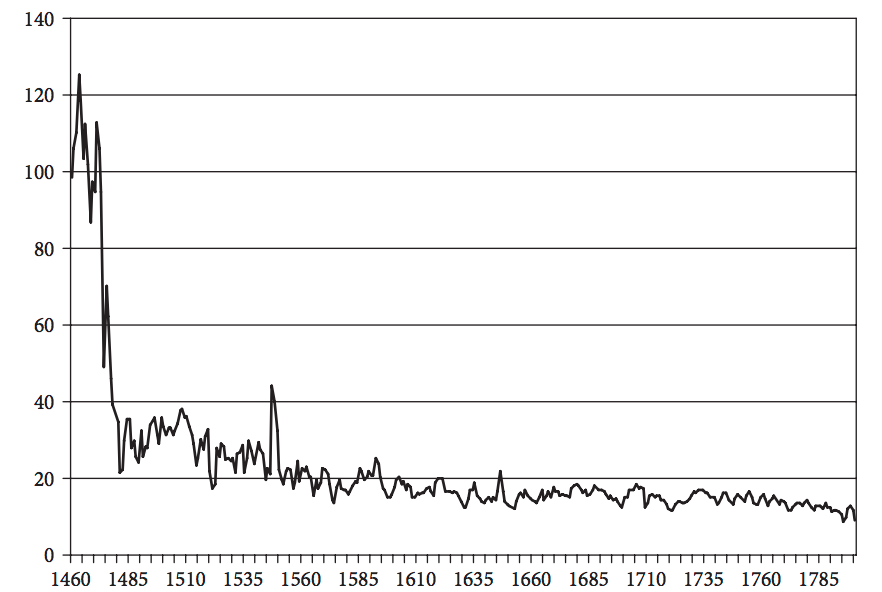
Increasing variation of genres
Another fundamental change in the book market after the invention of the book press was a very strong increase in the variety of printed books available to the readers. Dittmar (2012) measures the subject content by employing techniques from machine learning to identify the topics of books in his sample of English books between the late 1400s and 1700. He can thereby identify a specified number of topics in his sample and track the changes in variety over time. He depicts the increased consumer choice by calculating the Herfindahl index of topic concentration – this is reprinted in Panel A of the figure.
Panel B shows how the number of effective variety of consumer choices grew sharply after 1500. The increasing variety represents the end of the dominating role of theological texts – Dittmar (2012) notes that ‘almost all books were on religious topics in the late 1400s’.
Topic concentration and effective consumer variety of books, before 1700 – Dittmar (2012)6
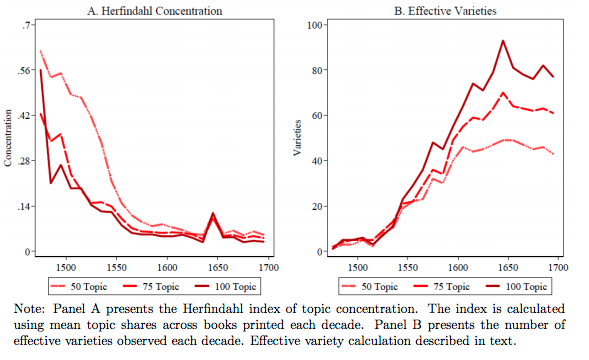
The pie chart gives an overview of the variety of book topics in London’s book market in 1700. Looking at the variety of books at that time – the end of Dittmar’s sample – makes one realize how dominant theological texts were before. The data source for this figure is the English Short Title Catalog or ESTC which is also one of the two sources of Dittmar.
London’s book market, 1700 – Wikipedia7
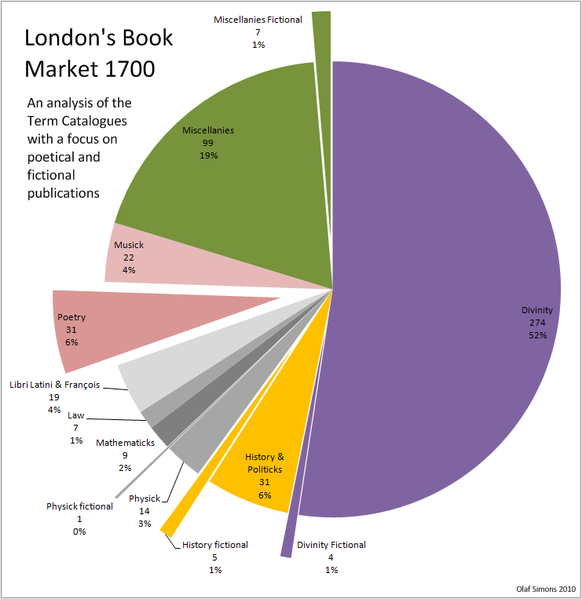
A subsequent change in the variety of topics was the rise of fiction literature. This marked change between the 17th and the 18th century is depicted here.
Statistic of titles the English Short Title Catalogue categorised as “fiction”, 1600-1799 – Wikipedia8
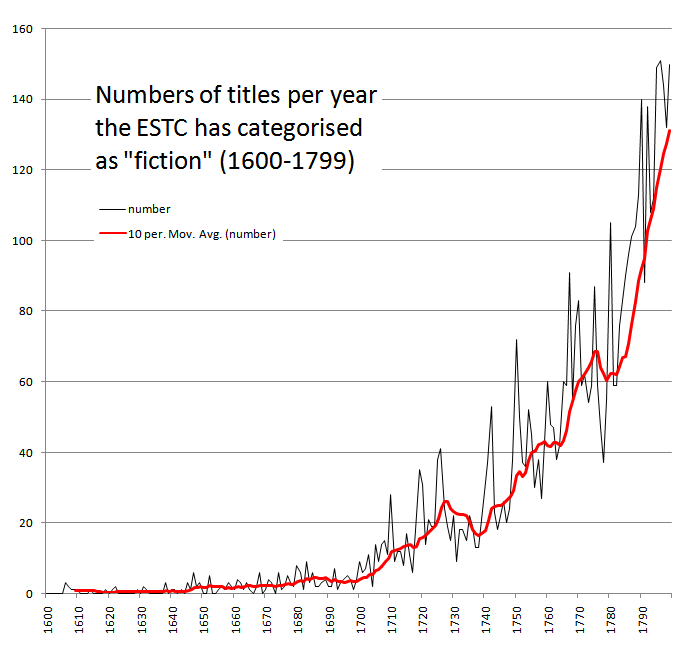
Consumption of Books
The declining price of books and the increasing literacy led to an increase in the consumption of books, as can be seen in this visualization.